
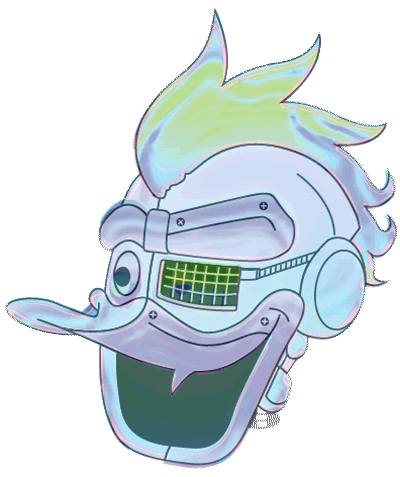
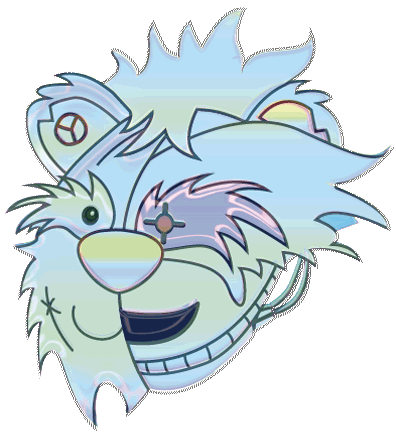
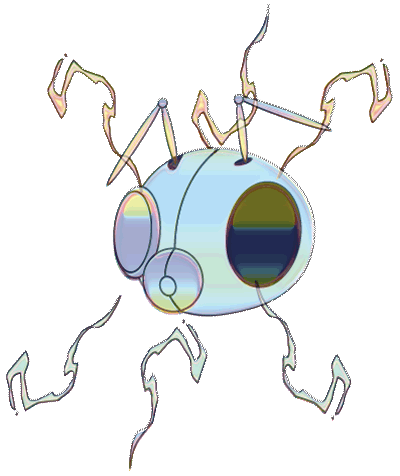
How Entropy8 and Zuper! became one: Entropy8Zuper!
3rd of April 2007, 7pm; I am standing outside a tall, narrow building in the centre of Gent, Belgium, waiting for Entropy8Zuper! to let me in. In that same morning, I talked to Auriea on the phone for the first time: our long relationship that developed online and took diverse manifestations –them the performers, me the audience; them the artists, me the curator; me the researcher, them the case-study…– was about to materialise. Our flesh bodies would soon be situated in the same actual space. On that morning it already took a voice: it was Auriea&s deep voice which I had heard before –but now, for the first time, it wasn’t computer-mediated.
The first time I saw a piece by Entropy8Zuper! was in 2001, at the Medi@terra festival in Greece (which I was co-directing at the time). That piece was Wirefire –and that was it… It meant I was hooked! I still have fading memories of “people without bodies mak(ing) love???1: I remember logging on my laptop on Fridays at about 1am (my time in Athens, Greece). I was there to watch the weekly performance of Wirefire that was on every Thursday night at midnight Belgium time for almost four years. The story behind Wirefire was about a couple, dispersed2, making love online, for and with audiences. Their act of virtual love-making was not a photorealistic representation of their encounter –it was love translated into audiovisual poetry: Auriea and Michael were mixing images, flash movies, animations, sounds, live streams and text files to create “compelling and seductive narratives???3 that all narrated the same story: “being digital and being in love???.4
Auriea opens the door. I see an elegant black woman, tall and slim, with long rasta locks, inviting me in what is both their house and studio. Michael is standing behind her: he is of about the same hight as her, also slim, white, with greying hair and what looks to me like a massive beard. Both seem to be in their late thirties or early fourties. Soon, we are sitting around a long dining table, on some funky, squeaky chairs. This is their living-dining room, simple, modern, and playful. There, over a few glasses of Bordeaux, Auriea and Michael talk to me for three hours about their art, life, and love-affair (which has a lot to do with both…).
How entropy8 and zuper! became one…
I have always been fascinated by Entropy8Zuper!’s love-story, which clearly was the inspiration for a lot of their early work. What I already knew was that they met and fell in love online while based in different countries (well, continents…), that they started working together while physically afar, and that they eventually decided to move in together. So Auriea gave up her life in NYC and moved to Belgium to live with Michael. But I didn’t know all the detail: Where and how did they meet? Did they fall in love at first (virtual) sight? What happened then? How difficult was it for both of them to decide to give up their lives for each other? Why is it that their work is so intrinsically interlinked with their love-affair?
“I guess it starts in Hell??? says Auriea. “What is she talking about???? I think. “I mean, in hell.com5??? she laughs. Oh god, that’s funny… What a semantically rich beginning to a career soaked in symbolism! Entropy8Zuper! have based a lot of their work (Godlove Museum, Wirefire) on allegory, and have used ‘grand narratives’ such as the Bible and folk fairytales as sources of inspiration. Auriea explains how she joined hell.com while Michael was already a member, how she knew and admired his work, and how they met there in January 1999 during a rehearsal for a collaborative, online video-performance using i-visit.6 Exactly how this happened is, Auriea says, “shrouded in mystery???.
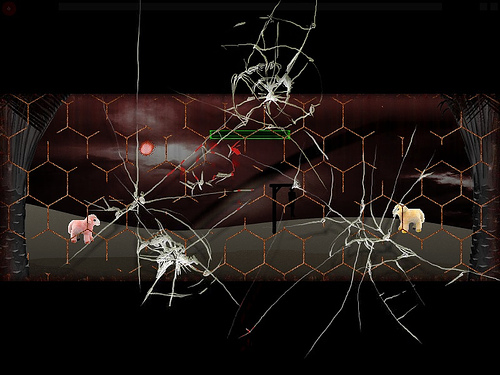
Image from Godlove.
A: I had a web-cam running all the time –this is why I was interested, I had a streaming web-cam online. It was black and white and I used to do sort of informal online performances. So anybody who came to my web-page would see me sitting at my desk but sometimes I would do fun things with the camera. So when I showed up I was talking to Lia7 -do you know Lia? She is from Austria (…) And Michael didn’t have a web-cam so I remember he was broadcasting images of fruits and vegetables, ha ha! (…) maybe subconsciously I was attracted! (…) Yeah, that’s when we started talking and, I don’t know, it became sex-chat more or less instantly (…) which was odd because, you know, we don’t do that! Ha ha!
So it was love at first sight! And this –can you imagine?– despite the fact that Michael looked like a cauliflower!… That is how the roller-coaster of their relationship starts: the next day, Auriea says, Michael sent her an html page: “I was very excited and so I made one in return. It went back and forth like that, and that’s how skinonskinonskin got made.??? skinonskinonskin is E8Z!’s first piece. Not surprisingly, it talks about love, desire, and fantasies of sexual encounters. Originally, the piece was not even meant for audiences, it was only meant for each other. Until the hell.com server operator found the directory, ‘fell in love’ with the project, and suggested that they open it up to audiences… Eventually, E8Z! presented the piece during the hell.com pay-per-view event (September 1999): they charged audiences for admission to the skinonskinonskin website. The event was quite successful and any income generated was split between the hell.com collective.
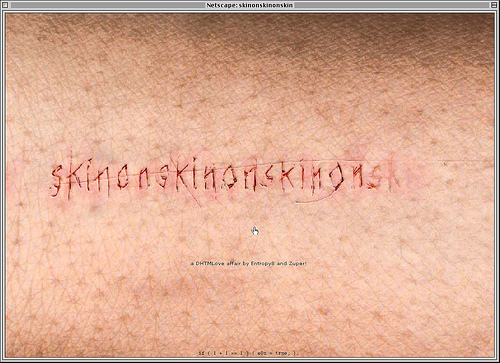
Image from skinonskinonskin
After skinonskinonskin came Genesis (1999), chapter one of the Godlove Museum. This was while they were trying to suppress their online passion and just work together. Genesis was supposed to be their business website, “this totally animated crazy thing, you know?!??? shouts Auriea, and it was launched the same day they physically met for the first time:
A: (…) when we finally met in person, this occasion was complete fate in some ways… He was going to be in San Francisco, and I had to be in San Jose and I thought ‘this is ridiculous, we are going to be there in the same week’, you know… So I went to San Francisco, and that is where we met in person. We launched entropy8zuper.org the same day that we met! We met, we launched the site, and then we sat and…
M: …talked! Ha ha! Amongst other things..
A: At the Triton Hotel in San Francisco (…). We were very big on doing these kind of symbolic acts, like meeting in Hell for the first time and then launching the website the first time we met in person…
A lot of E8Z!’s work is autobiographical (skinonskinonskin, most of the Godlove Museum, Wirefire), in that it is centred around their private lives, their remote love-affair, and their dramatic get-together. “I think it was based on that very heavily??? says Auriea, “but we tried to get away from that after a while???. It seems that their love affair, while very romantic, was also quite traumatic for both of them: they were both in relationships and Michael had two kids; they lived in very different cities; they both had different lives and different visions of the future… Within a period of just a few months, they decided to abandon their separate lives in order to start a joint one. This was beautiful, but it was also painful, says Michael. This is why their work of that period is so self-referential: to them it functioned a bit as therapy. Some of it was even too personal or too painful to publish…
The point when they decided that they had talked enough about themselves and had to start reconnecting with the world around them, was when they were making Numbers (2002), chapter 4 of the Godlove Museum:
A: We have a little desert scene and there are these bubbles that you can click on. And that is basically us saying goodbye to this, goodbye to that…
M: (…) the bubbles contain pictures of memories.
Auriea’s moving to Europe in May 1999 coincided with a politically unsettled time and the NATO \\”intervention\\” in former Yugoslavia. The political situation of the time shook them up and reminded them that they were not alone; they had to start making art for the people: “(M:) An American coming to Europe while Clinton is bombing Yugoslavia… The world started linking with our relationship.???
The Godlove Museum, Wirefire and net.art: is it or is it not?
Wirefire started in 1999 as a continuation of skinonskinonskin: like skinonskinonskin, this was an environment for them to meet and ‘make love’. But Wirefire was much more than that: it operated in three different modes, Random, Live, and Replay. The Random mode meant that people could visit the site online and, by clicking on Play, they could generate a new automated performance as the machine would mix audio and visual files in real time. The Live mode was a weekly performance of Wirefire where E8Z! would mix the files themselves for live audiences. This was different as they would also add elements such as web-cam streams, chat, and special effects. The live audiences were visible on the screen as specs of dust, and could also contribute text through the chat which E8Z! would integrate into the audiovisual landscapes.
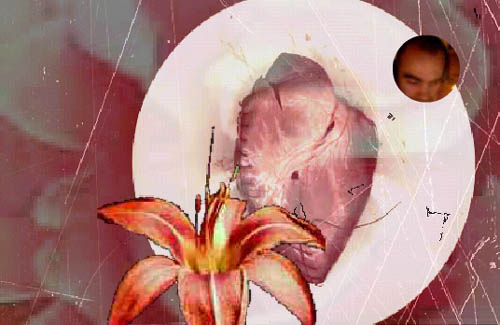
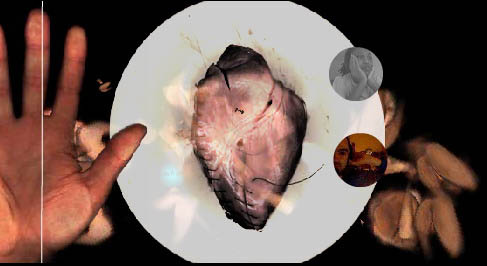
Images from Wirefire.
Wirefire was, in a way, the performance of the Godlove Museum, as it was recycling all the imagery made for it. So, as the Godlove Museum is based on the Bible, Wirefire also uses allegorical imagery of bees and sheep, raw meet and fire, to narrate the biblical story of Moses’ search for the promised land among war and all the monstrosities that come with it. E8Z! stress that Wirefire was a technically complex piece at the time, strong on visuals and sound. Indeed, I see it as a sensually ‘luxurious’ piece, with explosive bursts and luscious mixes of colours, textures and sounds, like a grand baroque fête… This feast of the senses that is often characteristic of E8Z!’s work is very unlike other net art (or net.art) works of the time, which are more conceptual than visual. Works like Heath Bunting’s Identity Swap Database (1999)8 for example, or Vuk Cosic’s History of Art for Airports (1997)9 are minimal, dry, with a sense of subtle humour and lots of irony. Auriea and Michael are fairly sceptical about that type of work, while they seem to be both melancholic and slightly bitter about the net.art movement. To start with, although they were working on the net at the same time like the people now considered to be ‘the net.artists’, they were never classified by art historians as part of this movement. Which is fair enough, they say, as they never saw themselves as part of this either…
A: We had some issues with that at the time, ’cause we weren’t considered net artists at all, and we didn’t really consider ourselves that either. We were doing design work more than anything else –I mean, not for our own projects, but we were web-designers and were doing projects for other people (…) So we didn’t really feel a part of anything, but there was nothing to be a part of in some ways, you know what I mean?
M: We felt part of the community I think, but not necessarily part of the genre. I remember us being angry with all their flashing pixels (…), and they were always making art about the Internet (…)
There has been a lot of discussion about the net.art movement lately, particularly with books like Rachel Greene’s Internet Art10 coming out. According to Greene, the core ideas related to net.art were \\”a serious engagement with popular media, a belief in parody and appropriation, a scepticism towards commodified media information and a sense of the interplay of art and life.\\” I read this quote out to E8Z! and ask them whether they think that their work fits into this description. Auriea originally says yes, and makes an effort to explain why –but the common ground is not that obvious… She talks about appropriating the Bible and fairytales as the subjects of their work. But then Michael says, no: “it’s more recuperation than appropriation (…) because we come from a Christian society, so it’s not appropriation when we talk about Christian mythology.??? So do they fit Greene’s description? Well, I think not: their art is romantic and epic rather than sceptical; I cannot see any parody in it as E8Z! tend to take things rather seriously; I don’t believe that they engage with popular media in any critical way –they probably engage more with baroque paintings; and yes, there is an interplay between art and life but that is mostly because their art is about their lives.
Other than sensually dry and aesthetically minimal, net.art is also often related to tactical media practices, hacking, activism (and ‘hactivism’), socially engaged systems, and community-building. I think that net.art has been more directly critical of politics, the society, the art system and itself than the work of E8Z! which, although not devoid of social commentary, is poetic, romantic, and timeless –thus lacking in specificities of time and space that are important to any political work. What do they think about that? Do they consider their art to be ‘political’ in any way? Michael is quick to respond:
M: I think both of us have always been very critical of people who are critical, ha ha! So activism was always very suspicious for us. It was I think because it always seemed so trendy and insincere.
MX: Why insincere?
M: Because I find it very easy to sit there and be an activist artist… If you really want to do something there are better ways of doing it…
That reminds me of a quote by playwright Tom Stoppard, who was accused in his early days of refusing to take a clear political position through his art:
I’m not impressed by art because it’s political, I believe in art being good art or bad art, not relevant art or irrelevant art. The plain truth is that if you are angered or disgusted by a particular injustice or immorality, and you want to do something about it, now, at once, then you can hardly do worse than write a play about it. That’s what art is bad at. But the less plain truth is that without the play and plays like it, without artists, the injustice will never be eradicated.11
The more we talk, the more I think that E8Z! feel very strongly about certain issues: to them, art is communication and entertainment more than anything else. This is not to say that they are not concerned about the social conditions they live in, or that they don’t care about politics. Indeed, they made clear that the last chapters of the Godlove Museum were made as a reaction to the political situation of the time. They compare George Bush’s speech during the declaration of the war against Afghanistan to “they say it was God???’s [M] speech in the Bible: “when the Israelites had already left Egypt and were approaching the Promised Land, God was encouraging them to take this land by force, kill and rape the people who lived there, or make them their slaves. All justified by the fact that the Israelites were The Chosen People.???12
What I gather from all this is that E8Z! are idealists: they really believed that net art could make a difference for the people, and have suffered a disillusionment in that respect: “net.art did not make a social difference???, says Auriea. They believe that while the origins of the movement were rooted within a healthy reaction against the traditional art system, now ‘net artists’ are more than happy to operate within this same system, show their work in galleries, and sell it to Museums.
A: Everyone was making work (…) and it was great fun, but it wasn’t like ‘oh we ‘re making art!’ you know?! Or ‘put me in your museum now please’… It became like that I think, but it definitely wasn’t that! So it felt a little strange after a while…
M: (…) Well, it’s even worse (…). There were ironical statements like ‘this is net.art’ and all that… This was complete self-mockery basically, but I think by now people are actually taking that stuff seriously!Ha ha!
A: (…) And at a certain point there was the ritual hanging of net art, you know? Net art sort of died as something that people believed in I guess…
M: Yeah, mostly because the artists wanted to be in the museums, ha ha!
A: (…) I don’t know what caused it but it seems that now net art is something people write essays about, it’s not something that lives and people are making. (…) that is what it was made out like, you know, like ‘net art is this thing that happened in a certain year, by these certain practitioners, certain sites’… I mean it was just there for everyone who wanted to participate (…) it was interesting, productive (…). Well, I thought it was part of the development of the web and that turned out to be wrong! It felt like this was making some sort of difference in what people thought about the web, either politically or whatever… But that may or may not be true, I guess time will tell.
It seems to me that E8Z! feel let down by both the net art communities, and the art historians who have failed to talk about their work because it doesn’t neatly fit into what later became known as the ‘net.art movement’. They keep pointing out that E8Z!’s practice is interdisciplinary, merging art and design (applied arts). They stress their disbelief in conceptual art, which they see as ‘smart’ art. They think that a lot of net.art is conceptual, which to them means elitist, while pretending otherwise. As far as they are concerned, artists have to consciously consider their audiences. This became very important to them once they decided to stop producing self-referential art: they really want to address people and involve their audiences in a two-way communication. Which is why they don’t like showing their work in galleries: they run away from the art system, Auriea says, to the web, which at the time seemed to be less hierarchical and more open to communication and exchange; why would they want to return to the art-world?
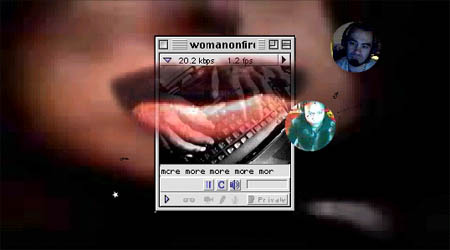
Wirefire ends in 2003:
A: Wirefire just ended because… –well, we decided to end it, ha ha! We decided ‘this will be the last one’ while we were doing it… Because I think we could see which way the wind was blowing on the Internet and we thought ‘the net is not the same place like when we started’. (…) We had been feeling like that for a while, that Wirefire was a relic in some ways, and we should sort of pack it away a little bit… And also our private meetings to work things out and connect with each other in that way was not something we needed any more I think –we had already been living together for three or four years… So we decided that we were not going to expand the project –which is what it needed– and so we should stop doing it and make something else. That’s why we made The Endless Forest (…).
What happened next? To be continued…
skinonskinonskin:
http://entropy8zuper.org/skinonskinonskin
Wirefire:
http://www.entropy8zuper.org/wirefire/i.html
The Godlove Museum:
http://entropy8zuper.org/godlove
Tale of Tales:
http://www.tale-of-tales.com